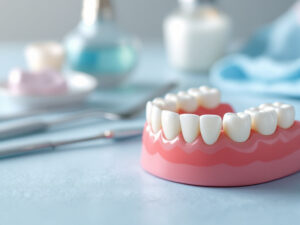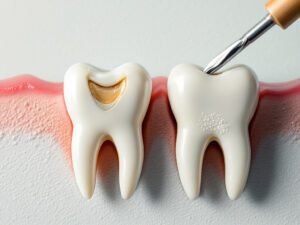Repairing a cracked tooth starts with finding a repair cracked tooth dentist who understands both the function and aesthetics of your smile. Whether you’re dealing with a small fracture or a deep crack that exposes inner layers of the tooth, timely restoration can prevent pain, infection, and tooth loss. In this guide, you’ll learn how a dentist evaluates cracked teeth, the most effective treatment options—from fillings to crowns and implants—and how to protect your teeth from future damage.
By understanding causes, symptoms, and restorative procedures, you can make informed decisions about your dental care. You’ll also get practical advice on preventive measures, insurance coverage, and cost estimates to ensure a smooth treatment journey. Let’s explore what you need to know to restore strength and confidence to your smile.
Understand cracked teeth
A cracked tooth can range from a tiny hairline craze line to a vertical split that extends below the gum. Known clinically as Cracked Tooth Syndrome (CTS), this condition can involve damage to the enamel, dentin, or pulp. Without treatment, cracks may worsen, leading to infection or tooth loss [1].
Common causes
- Biting down on hard foods or objects, such as ice or popcorn kernels
- Using teeth to open packaging or bottles
- Accidents, falls, or sports injuries
- Teeth grinding (bruxism) or clenching
- Age-related weakening of tooth structure [2]
Key symptoms
- Pain when biting or chewing that may come and go
- Sensitivity to hot, cold, or sweet foods and beverages
- Discomfort that is hard to pinpoint
- Swelling or tenderness in adjacent gum tissue
- Visible crack or rough edge on the tooth surface
If you notice any of these signs, you should schedule an exam with a dental restoration clinic as soon as possible.
Seek professional evaluation
Accurate diagnosis is essential for effective treatment. A repair cracked tooth dentist uses a combination of clinical tests and imaging to pinpoint the crack’s location and severity.
Dental exam techniques
- Visual inspection under bright light to identify visible cracks
- Bite tests using special tools to isolate the affected tooth
- Application of dental dye or staining solution to highlight fractures
- Percussion and palpation to assess pain response
Diagnostic imaging
- X-rays may reveal cracks in roots or below the gumline
- Cone beam CT scans provide three-dimensional views for complex cases
- Transillumination (light passed through the tooth) can detect hairline fractures
Based on these findings, your dentist will recommend the most appropriate restorative dental procedures.
Explore treatment options
Treatment varies with the crack’s severity, location, and depth. Here’s a summary of common interventions:
| Treatment | When used | Pros | Cons |
|---|---|---|---|
| Bonding or filling | Small cracks in enamel | Quick, conservative, low cost | Limited strength, may stain over time |
| Dental crown | Moderate cracks extending into dentin | Strong protection, long-lasting | Higher cost, requires more tooth reduction |
| Root canal therapy | Crack reaches pulp or nerve | Saves tooth, eliminates infection | Invasive, may require crown after treatment |
| Extraction | Severe vertical cracks or split roots | Removes source of pain and infection | Requires replacement (bridge, implant, denture) |
Bonding and fillings
For minor cracks, composite fillings or bonding restore function and appearance. The dentist applies tooth-colored resin into the crack, then shapes and polishes it to match your natural enamel. This service parallels a composite filling service and is often performed by a tooth filling dentist.
Dental crowns
When cracks reach the dentin, a crown provides full coverage and reinforcement. Crowns can be made of porcelain, ceramic, or metal alloys. Your dentist will prepare the tooth, take impressions, and place a temporary crown while the permanent one is crafted. Once ready, they’ll complete the dental crown placement or porcelain crown restoration, restoring strength and aesthetics.
Root canal therapy
If bacteria have entered the pulp through the crack, a root canal therapy is required. During this procedure, your dentist removes infected tissue, cleans the canal, and seals it with biocompatible material. A crown is then placed to protect the treated tooth.
Extraction and replacements
In cases of deep vertical fractures or splits, saving the tooth may not be possible. Extraction is followed by replacement options such as:
- Dental bridge replacement: Uses adjacent teeth as anchors [3]
- Implant restoration: A titanium post and crown by an implant restoration dentist
- Custom denture services: Removable prosthetics tailored to your bite [4]
Each solution has unique benefits. Implants offer durability and preserve jawbone, while bridges and dentures can be more cost-effective initially.
Consider restorative services
Beyond cracked tooth repair, you may need additional treatments for optimal oral health. Your dentist can coordinate multiple services to fully restore function and appearance.
Bridge and crown dentistry
Combining crowns and bridges addresses multiple missing or damaged teeth. A bridge & crown services plan can replace teeth in one or both dental arches, ensuring a seamless smile.
Implant and prosthetic options
Dental implants anchor crowns, bridges, or dentures directly to the jawbone. As part of dental prosthetics services, implants prevent bone loss and provide stability for chewing and speaking.
Insurance covered restorative dental
Many restorative procedures are covered partially or fully by dental insurance. An insurance covered restorative dental policy may include bonding, crowns, bridges, and even implants. Check your plan details or ask your provider to explore benefits.
Prevent future cracks
Once your tooth is repaired, you’ll want to protect against new damage. Adopting healthy habits and using protective devices can extend the life of restorations.
At-home care
- Brush twice daily with a fluoride toothpaste
- Floss daily to remove plaque and debris
- Use a soft-bristled toothbrush to minimize abrasion
- Rinse with an antibacterial mouthwash to reduce bacteria
Lifestyle adjustments
- Avoid chewing ice, popcorn kernels, or hard candy
- Wear a mouthguard during sports to prevent trauma
- Address bruxism with a nightguard if you grind teeth
- Schedule regular checkups at a dental restoration clinic to catch issues early
By maintaining good oral hygiene and protective measures, you’ll reduce the risk of cracks and prolong the life of your restorations.
Estimate treatment costs
Cost varies based on the procedure, materials, and your location. Below are average ranges in US dollars:
| Procedure | Cost range |
|---|---|
| Bonding or filling | $100 – $500 |
| Dental crown | $800 – $1,800 |
| Root canal therapy | $700 – $1,500 |
| Dental bridge | $1,200 – $2,500 |
| Dental implant | $3,000 – 6,000 |
| Denture (per arch) | $600 – $3,000 |
Payment options
- Flexible spending accounts (FSAs) and health savings accounts (HSAs)
- Dental financing plans through your provider
- In-office payment plans that spread costs over time
Consult your dentist’s office to get a personalized estimate and discuss any available discounts or promotional offers.
Make informed decisions
Repairing a cracked tooth involves more than fixing a fracture—you’re restoring your smile, comfort, and oral health. By choosing the right repair cracked tooth dentist, understanding available treatments, and taking preventive steps, you set the foundation for a lasting outcome. If you have damaged, decayed, or missing teeth, explore dentistry for damaged teeth and tooth repair and restoration services to find comprehensive care tailored to your needs. Your new smile is within reach.










